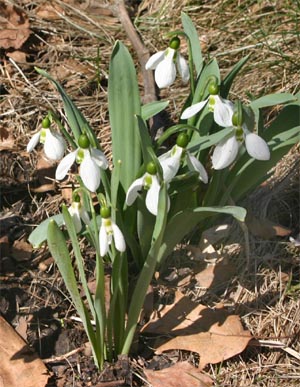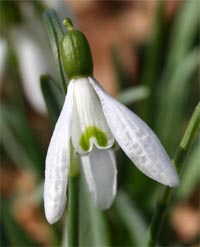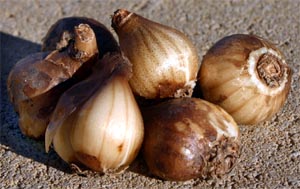
Snowdrops, Galanthus spp., are small, early-blooming perennial spring bulbs, even pushing through the snow in the coldest regions. The name Galanthus comes from the Greek gala (= milk), and anthos (= flower), referring to the color of the flowers and providing another rarely used common name of milkflower. There are about 19 species of Galanthus – in the amaryllis family (Amaryllidaceae), all native to the woods and wet, alpine grasslands of cool mountainous regions of southern Europe and Asia Minor. Most are hardy to zone 5 but some to zone 2. Snowdrops were used as a folk remedy for various ailments and were likely moved from their original habitats in Central Asia throughout much of Europe and the British Isles by midwives and monks who used it for medicinal purposes.

These are not showy plants, producing delicate-looking, solitary, pendant, white flowers. The waxy blooms have six petal-like segments (botanically tepals). The three outer ones are always longer than the inner ones and are solid white. The three inner ones are notched at the tip and are marked with green around this notch. The plants have two or three dark green, strap-like leaves that grow 4-10″ tall. The leaf tips are thickened sort of like a nail on a finger, protecting the flower bud as they push through the soil.
Common snowdrop, G. nivalis, has 4″ leaves that are ¼” wide and produces 1″-long flowers. It originated in eastern Turkey, the Caucasus, northern Iraq and western Iran and is hardy to zone 3. There are numerous cultivars of this species (one book has 500 listed – most only available in Europe); some of the more distinctive and readily available ones include:
- ‘Atkinsii’ (or ‘James Backhouse’) – robust grower that frequently has deformed flowers, or extra petals
- ‘Flore Pleno’ – double flowers, excellent for naturalizing in woodlands
- ‘Sam Arnott’ – large flowered and fragrant
- ‘Viridi-apice’ – outer segments green blotched, and more robust than the species
- ‘White Dream’ – has a white stripe on its leaves
Giant snowdrop, G. elwesii, is not as hardy, surviving reliably only to zone 4 or 5 but is still a vigorous plant. It has wider leaves (to 1″) and larger flowers (1¼ -2″) with a more conspicuous green blotch than common snowdrop. This species withstands hot weather better than the common snowdrop.
Other species, not commonly available for purchase, include G. byzantinus with longer leaves and smaller flowers, hardy to zone 5 and a better choice for southern gardens being a native of western Turkey; G. plicatus, Crimean snowdrop, has broad leaves folded back at the edges; the Greek species G. reginae-olgae which blooms in the fall and is also hardy to zone 5; and G. woronowii (often labeled G. ikariae latifolius in commerce) from Russia, the Caucasus, and adjacent parts of Turkey and Iran has recurved foliage and is listed by some as hardy to zone 2.

Snowdrops are sometimes confused with snowflakes (Leucojum spp.), which also has white flowers with green markings. However, Leucojum plants are usually taller, have 2-3 flowers per stem and their tepals are the same length.
These are small plants, so are best situated near walks, pathways, or in elevated gardens where their delicate beauty can be better appreciated. Also, since they bloom when the weather is often still quite cool, place them where they are visible from the house.

They look best when planted at least three or four plants together. They are attractive set against evergreens or interplanted in ground covers or with low-growing evergreen perennials such as candytuft (Iberis sempervirens) or spotted deadnettle (Lamium maculatum). They can be placed under deciduous trees or shrubs, at the edge of the border or woodland areas or even in the lawn (but that area should not be mowed until the foliage has matured, about 6 weeks after blooming). Because of their small size, snowdrops are ideal for rock gardens. Combine them with other early-blooming bulbs such as winter aconite (Eranthus hyemalis), Siberian squill (Scilla siberica), glory-of-the snow (Chionodoxa), and early, small daffodils such as ‘Tête-á-tête’ or ‘Jack Snipe’. They can even be used in containers and for forcing.

Grow snowdrops in a location that has full sun during the spring when the foliage is apparent. They prefer rich, well-drained soil. Plant the dry bulbs early in the fall but after the soil has cooled – generally when nighttime temperatures are in the 40ºFs and 50ºFs. Space the plants 3″ apart and set the bulbs 3″ deep. Fertilize in early spring when shoots first appear or after blooming. Allow the foliage to die back naturally after they bloom in the spring. Allow the soil where the bulbs are planted to dry out in the summer (if possible).
Snowdrops do not multiply as readily as some of the other small bulbs, often taking a few years to get established, but eventually will form large compact colonies if left undisturbed. They may produce new plants from seed, taking about 4 years to bloom, or they can be propagated by digging and dividing the bulbs immediately after flowering while the foliage is still green. Replant the bulbs immediately after digging. These bulbs have few pests and are not bothered by deer, rabbits, or voles and other rodents.
– Susan Mahr, University of Wisconsin





 Aster, Symphyotrichum spp.
Aster, Symphyotrichum spp. Fascinating Fasciation
Fascinating Fasciation Alternatives to Lawn: Groundcovers
Alternatives to Lawn: Groundcovers Marigolds
Marigolds


